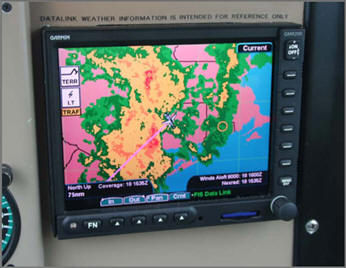 |
|
|
|
|
|
|
|
|
Although such situations are not believed to be typical,
in extreme latency and mosaic-creation scenarios, the
actual age of the oldest NEXRAD data in the mosaic can
EXCEED the age indication in the cockpit by 15 to 20
minutes.
On
March 25, 2010, a Eurocopter AS350 B3, N855HW, impacted
terrain near Brownsville, Tennessee.2 During the flight,
the pilot’s cockpit display indicated that it had
received one NEXRAD image roughly halfway through the
flight that indicated it was about 1 minute old;
however, the weather conditions were actually about 5
minutes old. The image indicated that the severe weather
was about 7 miles away from the home base where the
pilot was attempting to land, but the severe weather was
actually just crossing over the home base at about the
time the display received the NEXRAD image.
On
December 19, 2011, a Piper PA-32-260, N3590T, collided
with terrain following an in-flight breakup near Bryan,
Texas.3 The pilot had been diverting to avoid weather
and had likely received several NEXRAD updates in the
minutes leading up to the accident. According to the
NEXRAD data the pilot likely would have received, he was
flying clear of the precipitation along the edge of the
rain.
Near the end of the flight, the pilot flew into a
section of the developing rain shower. His display
should have shown that he still remained clear of the
precipitation. The last three NEXRAD updates that the
pilot received should have each said that they were 1
minute old at the time they were received; however, the
actual weather conditions at the time the images were
received in the cockpit were about 6, 7, and almost 8
minutes old, respectively.
The general issue of latency with in-cockpit NEXRAD is
discussed in pilots’ guides, in industry literature, and
on service providers’ websites. However, the NTSB has
not found that such guidance contains details about the
potential time difference between the age indicator and
actual conditions.
What can pilots do?
Remember that the in-cockpit NEXRAD display depicts
where the weather WAS, not where it IS. The age
indicator does not show the age of the actual weather
conditions but rather the age of the mosaic image. The
actual weather conditions could be up to 15 to 20
minutes OLDER than the age indicated on the display. You
should consider this potential delay when using
in-cockpit NEXRAD capabilities, as the movement and/or
intensification of weather could adversely affect safety
of flight.
Understand that the common perception of a “5-minute
latency” with radar data is not always correct. Get
your preflight weather briefing! Having in-cockpit
weather capabilities does not circumvent the need
for a complete weather briefing before takeoff. Use
all appropriate sources of weather information to
make in-flight decisions. Let your fellow pilots
know about the limitations of in-cockpit NEXRAD.
|
||||
|
|
||||


